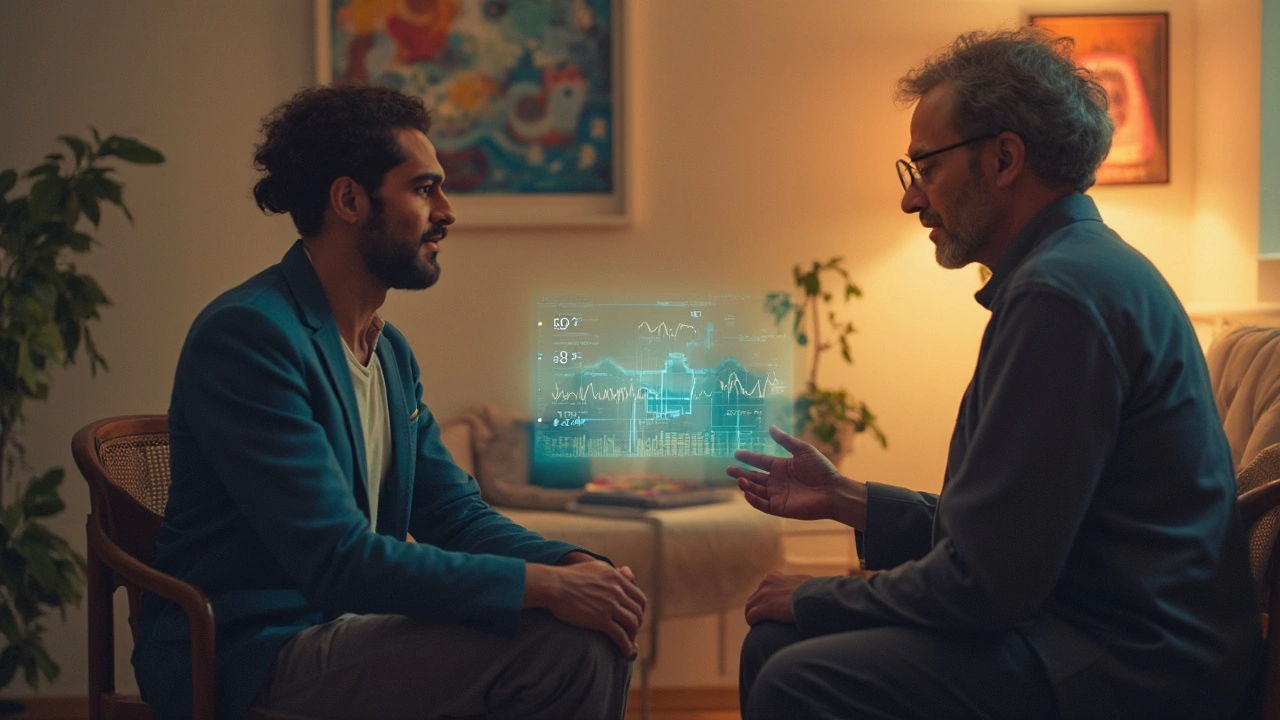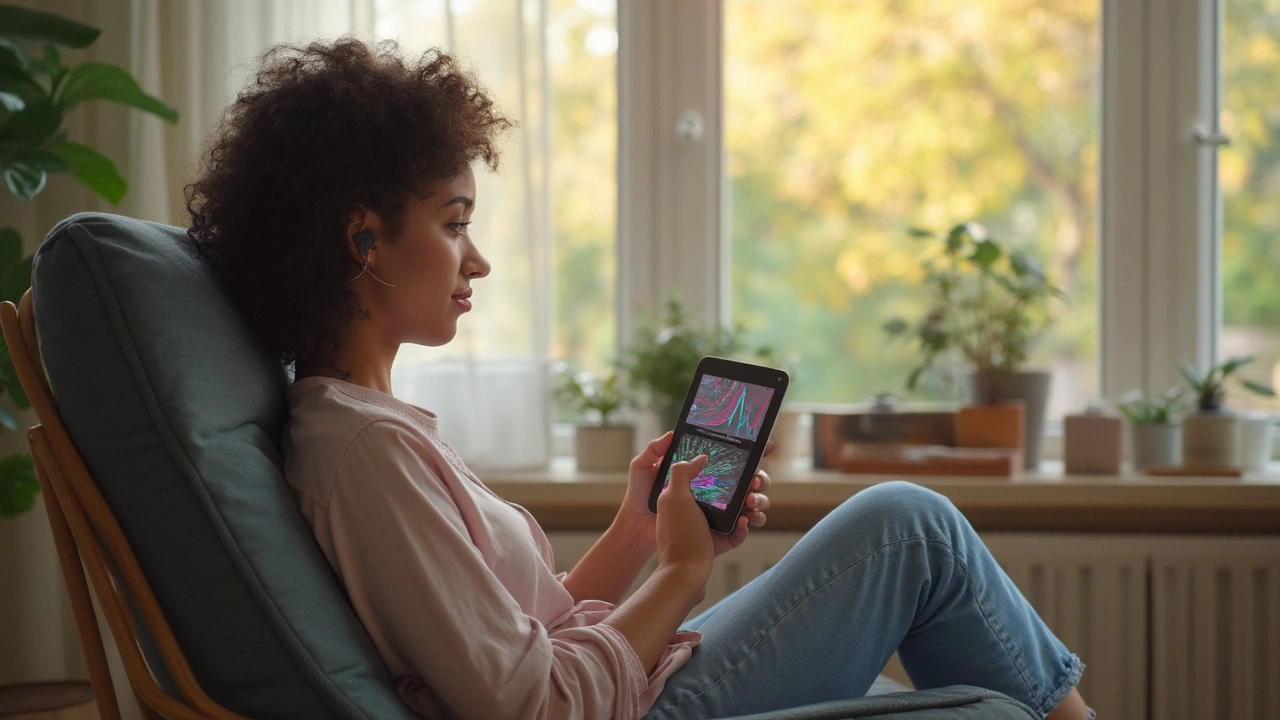Here’s something wild: you can train your mind and body to handle stress just by watching how your body works in real time. It sounds straight out of a sci-fi flick, but biofeedback isn’t science fiction—it’s science fact. You slip on a sensor, watch a screen, and see things like your heart rate or skin temperature change as you breathe or tense your muscles. The coolest part? People who try biofeedback can learn, with practice, to calm those crazy stress signals before they spiral out of control. We’re living in a world that keeps our brains buzzing almost non-stop. There’s the constant ping of notifications, pressure at work, family stuff, and, well, just being a human these days. Biofeedback skips the bottled lightning and gets right to the source: your nervous system.
What Is Biofeedback and How Does It Work?
If you thought controlling your heart rate sounded impossible, meet biofeedback. The word itself sums it up: you get ‘feedback’ from your biological signals. This isn’t witchcraft or wishful thinking. It uses sensors that stick to your skin and feed real-time data—think heartbeats, muscle tension, even skin moisture—back to a computer or a little device. The machine spits out graphs, gauges, or even games that show your stress levels changing right before your eyes. In a biofeedback session, you might see a jagged graph representing your frantic state during a tense moment, and then, as you follow deep breathing cues, watch that line smooth right out. That’s you—taking control.
This tech came out of some seriously interesting experiments in the late 1960s. Neuropsychologist Joe Kamiya made headlines when he proved people could learn to alter their brainwaves on command, just by getting feedback. By the 1970s, biofeedback machines hit clinics and even living rooms, showing up everywhere from research hospitals to Olympic training centers. Today, the gadgets have gone portable. Wearables the size of a matchbox or even phone apps with finger sensors make it possible to practice biofeedback at home, on the train, or hiding in a bathroom at work when life goes sideways.
Beneath all the wires and graphs is a simple idea: awareness leads to control. Imagine getting a warning LED on your forehead every time your stress ramps up. With biofeedback, your hands get sweaty, blood flow patterns shift—the sensor captures it, your screen flashes, and you know it’s time to regroup. No more guessing what’s going on under your skin.
Check out some of the main types:
- Electromyography (EMG): Measures muscle tension. Handy if your jaw clenches every time you run late for school pickup.
- Heart Rate Variability (HRV): Tracks the tiny changes between each heartbeat, which signals how your nervous system is balancing stress and calm.
- Galvanic Skin Response (GSR): Looks at how much you sweat, even if you don’t notice it yourself.
- Temperature Feedback: Cooler fingers mean stress, while warm fingers signal relaxation. Easy to track with a little clip-on sensor.
- EEG (Electroencephalography): Reads your brainwaves to show patterns tied to stress or focus.
Here’s a handy look at what gets measured:
| Biofeedback Type | What It Tracks | Typical Use |
|---|---|---|
| EMG | Muscle tension | Jaw or neck pain, back pain |
| HRV | Heart rate fluctuations | Stress, anxiety, heart health |
| GSR | Skin conductance | Emotional arousal, anxiety |
| Temperature | Peripheral blood flow | Migraine, stress triggers |
| EEG | Brain activity | Attention problems, relaxation training |
Why Biofeedback Works for Stress Management
If you’ve tried deep breathing or a guided meditation, you know sidestepping stress isn’t just about chilling out and hoping for the best. Biofeedback throws you a lifeline by showing—right in real time—exactly how your body reacts to stress. Once you spot your stress ‘signature,’ you get better at hitting pause. For loads of people, seeing that physical proof feels like getting x-ray vision into their own mind. If you see your heart thumping on the screen, you know your meltdown isn’t all in your head. When you watch your tension drop after slow, calm breaths or progressive muscle relaxation, your belief in your skills skyrockets. Suddenly, relaxation doesn’t feel fluffy or fake anymore.
The science backs it up, too. In a 2020 analysis from the International Journal of Environmental Research and Public Health, people who practiced HRV biofeedback for just four weeks had measurably lower stress and anxiety, and improvements lasted up to three months after the training. Another real plus: biofeedback isn’t just for folks with anxiety or panic attacks. Chronic pain sufferers, migraine warriors, and even kids with ADHD have reported a drop in symptoms, simply by learning their body’s clues and training calmer responses. Now, hospitals across Australia and the world include biofeedback in stress management programs or as part of chronic disease treatment plans.
You don’t have to plug into a monitor every day forever, either. The big win comes when you notice you can bring on calm all by yourself—no machines needed. Here are some clever tricks for using biofeedback at home to lower stress quickly:
- Start a quick HRV exercise with an app, focusing on slow, regular breathing for three minutes.
- If you use a smartwatch, try the ‘relax’ or ‘breathe’ function during high-stress times (think Zoom calls, work deadlines, awkward family chats).
- Pair skin temperature feedback with hand warmers. When your fingers start to feel cold during a tense call, take that as your cue to practice a few relaxing breaths.
- Make a habit of checking in with your stress sensors after big or small daily challenges—a traffic jam, a tough meeting, or even prepping for bedtime with kids.
If you’re competitive, try turning biofeedback exercises into a game—can you lower your heart rate faster each day? You’ll be surprised by the results and how quickly your body learns what to do, even when you’re unplugged.

Biofeedback Devices and Apps: What’s Out There?
Biofeedback tech isn’t just for clinics anymore. The market is full of wearables and apps built for real people who need to downshift stress fast. There are finger sensors that plug into your phone, like the Inner Balance by HeartMath. There’s the sleek Muse headband, using EEG to help train your brain to stay calm and focused. Fitbit and Apple Watch users—guess what? You’re already packing biofeedback power if you use heart rate or skin temperature features, though those are less targeted than specialty devices.
Smartphone apps like Breathe2Relax turn a regular phone into a stress-busting tool, walking you through guided breathing while tracking your progress. Some use the phone’s camera and flash to check your pulse so you can watch how breathwork really calms you down. For those who love gaming, there are biofeedback video games crafted to respond to your body. The more relaxed you are, the better you play—think of it as turning ‘chilling out’ into a high score challenge.
Prices run the gamut from budget-friendly under $100 to pro-level gear costing several hundred. The big question is always: which one’s right for me? For anyone new to the scene, apps with virtual guides work great for learning the ropes. If you’re dealing with stress that’s causing headaches or muscle pain, invest in EMG sensors or a simple thermal biofeedback device you can use at your desk or bedside. More serious chronic stress or medical conditions? Chat with a biofeedback-trained psychologist or occupational therapist. Australia’s stress specialists aren’t hard to find, and a few sessions with an expert can really kickstart your progress.
Before you splash out, remember:
- Stick to devices approved by regulators or recommended by registered health professionals.
- Check for tech support and updates—some gadgets lose value as software ages.
- Watch for hidden costs—many devices work with subscription-only apps.
- Read real user reviews to see if the tech actually works for regular, busy folks, not just professional athletes or neuroscientists.
One more thing: biofeedback works best when you treat it as part of your daily routine, not a magic fix. With every session, you bank more know-how about what calms you down and how your unique body ticks. Basically, you become the boss of your own nervous system.
Biofeedback and Daily Life: Tips, Stats, and What the Future Holds
Modern stress sneaks up on us: during work emails, traffic, or even vegging out in front of Netflix. Biofeedback isn’t just about special therapy appointments—it slides right into daily routines. How about using a pulse oximeter while you wait in line at Woolies? Or checking GSR readings before you answer a stressful call? Lots of Australians are getting creative with simple biofeedback tools for everyday chill—no appointment needed.
Evidence is stacking up. According to Mental Health Australia, one in five people report high or very high levels of psychological distress every year. But folks who use biofeedback, even just through wearables or guided app sessions, report fewer headaches, better sleep, and more focus, often within weeks. Stress management at the push of a button is no longer a dream. In fact, a 2024 survey found that Australians using biofeedback gadgets for just 10 minutes a day felt a 25% drop in work-related stress after a month. Pretty impressive for a tool that fits in your pocket.
Biofeedback isn’t limited to adults, either. Kids as young as seven are using simple biofeedback games for emotional control and focus in school. Older Aussies with hypertension, migraines, or ongoing pain are seeing fewer flare-ups and skipping meds more often thanks to regular biofeedback sessions. The best part? Unlike pills or quick-fix drinks, there’s almost no risk of side effects.
Looking ahead, biofeedback tech gets smarter every year. Next-gen gadgets might use motion sensors and AI to spot subtle shifts before you even feel them. Imagine your watch giving you a gentle buzz when your body first tenses up, so you can nip stress in the bud. Or smart home devices linking biofeedback with lighting or music to set the mood for calm without you lifting a finger. The only limits are in our heads—and, as biofeedback proves, those are more flexible than we think.
If you’re serious about working with your body—not against it—give biofeedback a shot. Ditch the guesswork and let technology show you what’s really stressing you out, one beat, breath, or blink at a time. One thing is clear: stress doesn’t stand a chance when you’ve got real-time feedback in your corner and a bit of biofeedback know-how on your side.





